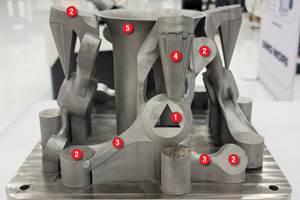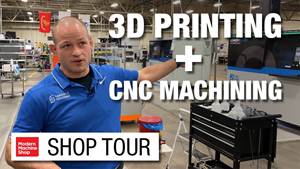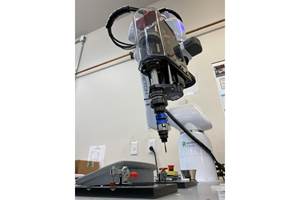Additive Mindset Can Aid Machinists
The mindset for additive flips subtractive thinking inside out.
Addition and subtraction are diametrically opposed. The former increases value by adding something of more value while the latter reduces the value of something by taking away from the original whole — at least in a mathematical sense.
In reality, though, people use subtraction all the time to increase the value of something. Sculptors create priceless statues from blocks of marble by carefully removing material. Woodworkers make beautiful furniture by carving away pieces of wood. Even Mother Nature subtracts, using rivers, for example, to erode the surrounding landscape to create beautiful scenery that people often pay to enjoy.
Machining professionals are masters of subtraction. They create parts and products that we value by removing unwanted sections from a larger billet of material. Like sculptors, they can see the final part hidden inside a block of metal and conceive of the tooling and fixturing needed to reveal it. I can imagine the internal dialogue as a manufacturer is presented a new part to make: “If I hold it this way, then I can machine that face and cut that away so that when I flip it and hold it here to ream that hole…” and on and on until the final part is obtained.
So how do you teach this subtractive mindset, or “outside-in” thinking? In schools, we teach students how to read and interpret 2D views and orthographic projections of the part, and then introduce them to subtractive manufacturing methods and tools, such as milling and lathes, via lectures, videos and hands-on labs. In industry, these skills are learned on the job and honed through years of practice and apprenticeships, much like young Padawans learn the Force from more seasoned Jedi. (Sorry, couldn’t resist — huge Star Wars fan!)
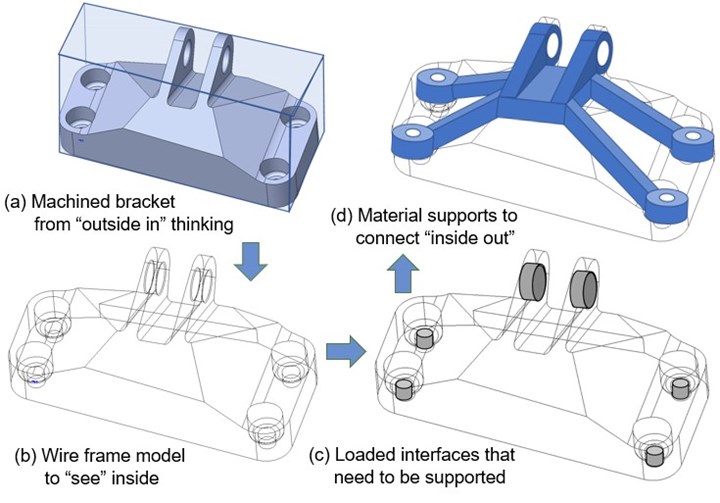
Example of shifting mindset from “outside in” to “inside out” thinking for a machined bracket from GE Bracket Challenge. It is inspired by Nigel Southway’s “wire frame thinking” figure on page 12 in the 2017 Canadian AM Guide published by Design Engineering.
Educational games have emerged to teach these skills. For example, Cube Cut from Simcoach Games is available for free on Android and Apple phones and products, and it is a fun and interactive app to learn about machining. Through a series of levels, you learn how to subtract material away from a solid block to make increasingly complex shapes and features. The Simcoach Games team has done a great job gamifying the learning process for subtractive manufacturing, and it is even starting to attract young people to consider jobs in manufacturing.
Topology optimization is in this same vein, as I discussed last month. Recall that topology optimization software uses computer algorithms to subtract material away in an existing part to make it lighter weight, for example. It mimics the outside-in mindset, and there are fun and interactive apps to learn topology optimization as well, such as TopOpt and TopOpt3D. Using these helps people visualize how a part can be made lighter without affecting its strength.
Additive manufacturing flips the subtractive mindset inside out. Instead of removing material to reveal a part from a larger billet, your thinking shifts to adding material from the interior, working your way to the outside boundary. You start by asking where and how much material does the part need to support the forces and loading it experiences or channel the fluids that may run inside it or dissipate the heat that builds up from within? Then you think about features or surfaces that need to be protected or enclosed, mating interfaces to attach other components and the additional loads or constraints that those connections impose. The list goes on as it is imperative to consider all aspects of how the part will be used when thinking this way.
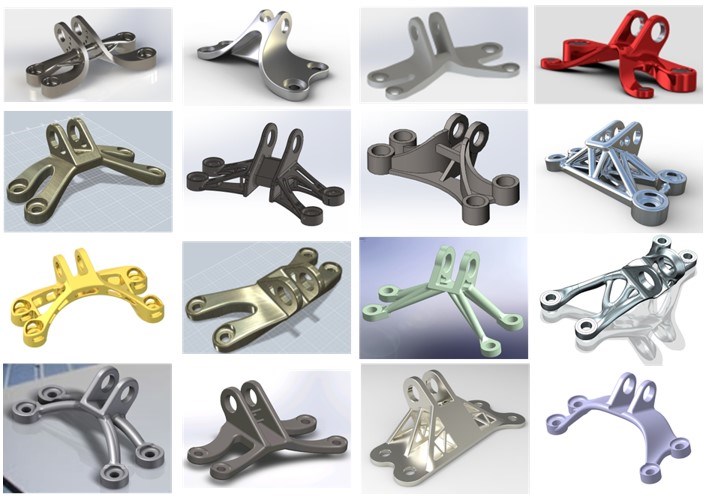
Sixteen examples illustrating “inside-out” thinking from hundreds of designs submitted to the GE Bracket Challenge (Available via GrabCAD).
This “inside-out” thinking is akin to growing a part, much like living organisms grow. This is why people often seek inspiration from nature when designing for additive manufacturing. In fact, websites like asknature.org allow you to search through over 2,000 biological strategies and innovations in nature to learn how different living organisms and creatures have evolved solutions to survive. The number of solutions that nature has evolved to manage impact, for example, is fascinating.
I think my inside-out mindset resulted from years of building LEGO, starting with a single brick or plate and building a complex and elaborate structure that can be used as a toy without breaking. A great example is the huge AT-AT set that stands over two feet tall and walks on articulating legs without breaking (as I said, huge Star Wars fan).
Kids these days playing Minecraft build houses, cities and entire worlds one “brick” at a time. As I watch my children play, switching from one type of brick to another, I can’t help but think how we might extend Minecraft to designing parts, one block of material at a time, starting from the inside and working out, adding different material in different regions of the structure to achieve different functions. Several additive manufacturing technologies give us some level of control during deposition — material jetting and directed energy deposition both spring to mind — but designing such parts in CAD software remains challenging.
This is where generative design software is giving rise to new algorithms and tools to help. Just imagine how long it would take to design and build an entire airplane, for example, brick by brick as if building LEGO or playing Minecraft. I can’t wait to be able to do that though!
Software tools will continue to evolve to nurture and support the inside-out mindset that helps users think additively, but don’t misunderstand. I am not arguing one mindset should replace the other, just like I will not argue that additive manufacturing will entirely replace subtractive manufacturing. It has never been an either/or scenario; it needs to be both, and that is the real mindset that we need to cultivate in manufacturing these days.
Related Content
Designing a 3D Printed Part with Machining in Mind
Designing extra stock and mounting features into a 3D printed part can aid in machining processes downstream.
Read MoreView From My Shop, Episode 2: 3D Printing and Postprocessing With Tangible Solutions
Collaboration between Tangible Solutions’ additive and machining departments simplifies their work. Learn more in this episode of The View From My Shop.
Read MoreHow Automation Keeps Quality Control in Control
Collaborative robots help inspection keep pace with machining in a custom, digitalized workflow for complex aerospace and defense parts.
Read MoreDigital Thread Enables First-Time-Right 3D Printing
Connecting all stages of manufacturing, from design to postprocessing, helps break down barriers to industrializing additive manufacturing.
Read MoreRead Next
Video: Is Additive Manufacturing a Competitor to CNC Machining?
Not at all, says Renishaw’s Robert Chiari. The manufacturing methods complement one another, which is why many machining facilities are looking to AM.
Read MoreObscure CNC Features That Can Help (or Hurt) You
You cannot begin to take advantage of an available feature if you do not know it exists. Conversely, you will not know how to avoid CNC features that may be detrimental to your process.
Read More3 Mistakes That Cause CNC Programs to Fail
Despite enhancements to manufacturing technology, there are still issues today that can cause programs to fail. These failures can cause lost time, scrapped parts, damaged machines and even injured operators.
Read More

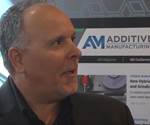





.png;maxWidth=300;quality=90)











